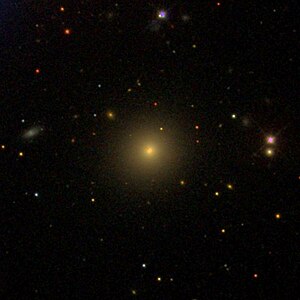NGC 2839
| Galaxy NGC 2839 |
|
|---|---|

|
|
| SDSS recording | |
| AladinLite | |
| Constellation | lynx |
|
Position equinox : J2000.0 , epoch : J2000.0 |
|
| Right ascension | 09 h 20 m 36.3 s |
| declination | + 33 ° 39 ′ 02 ″ |
| Appearance | |
| Morphological type | E? |
| Brightness (visual) | 14.2 mag |
| Brightness (B-band) | 15.2 mag |
| Angular expansion | 0.9 ′ × 0.9 ′ |
| Surface brightness | 14.0 mag / arcmin² |
| Physical data | |
| Affiliation | Abell 779 |
| Redshift | 0.027526 +/- 0.000067 |
| Radial velocity | 8252 +/- 20 km / s |
|
Stroke distance v rad / H 0 |
(367 ± 26) · 10 6 ly (112.6 ± 7.9) Mpc |
| history | |
| discovery | George Johnstone Stoney |
| Discovery date | March 13, 1850 |
| Catalog names | |
| NGC 2839 • PGC 26425 • CGCG 181-031 • MCG + 06-21-023 • 2MASX J09203631 + 3339030 • | |
NGC 2839 is an elliptical galaxy of the Hubble type E-S0 in the constellation Lynx in the northern sky . It is an estimated 367 million light years away from the Milky Way and has a diameter of about 100,000 ly.
In the same area of the sky are the galaxies NGC 2825 , NGC 2829 , NGC 2831 , NGC 2834 .
The object was discovered on March 13, 1850 by George Johnstone Stoney , an assistant to the astronomer Lord Rosse .
